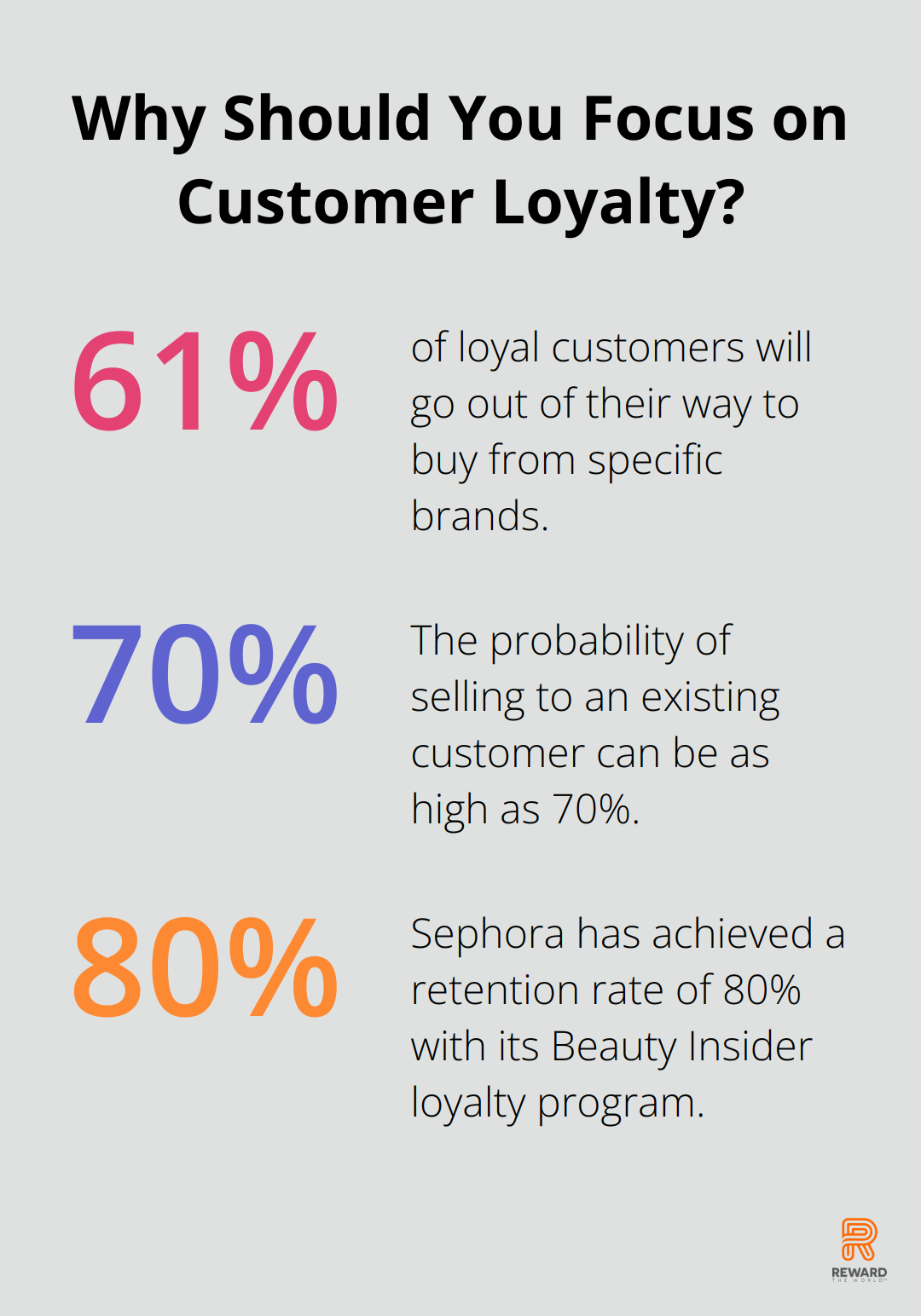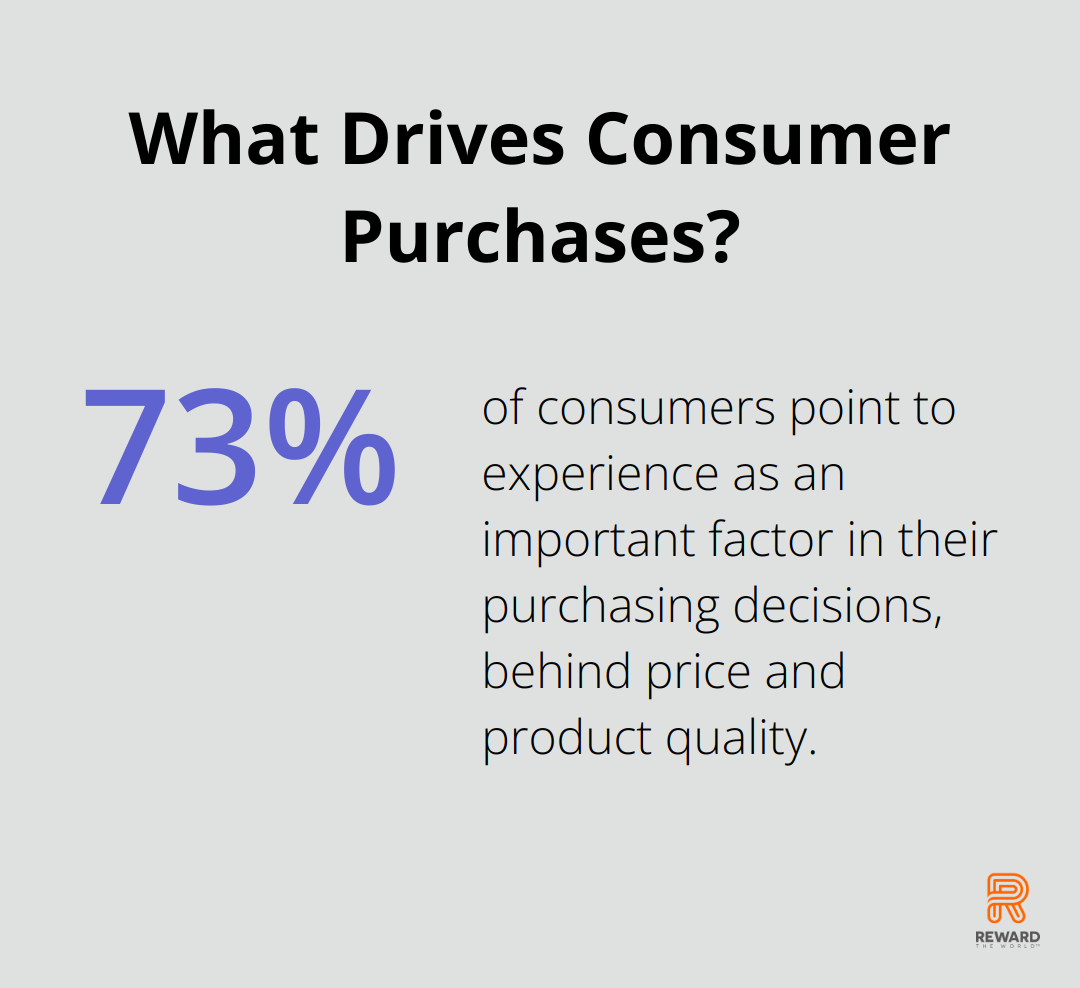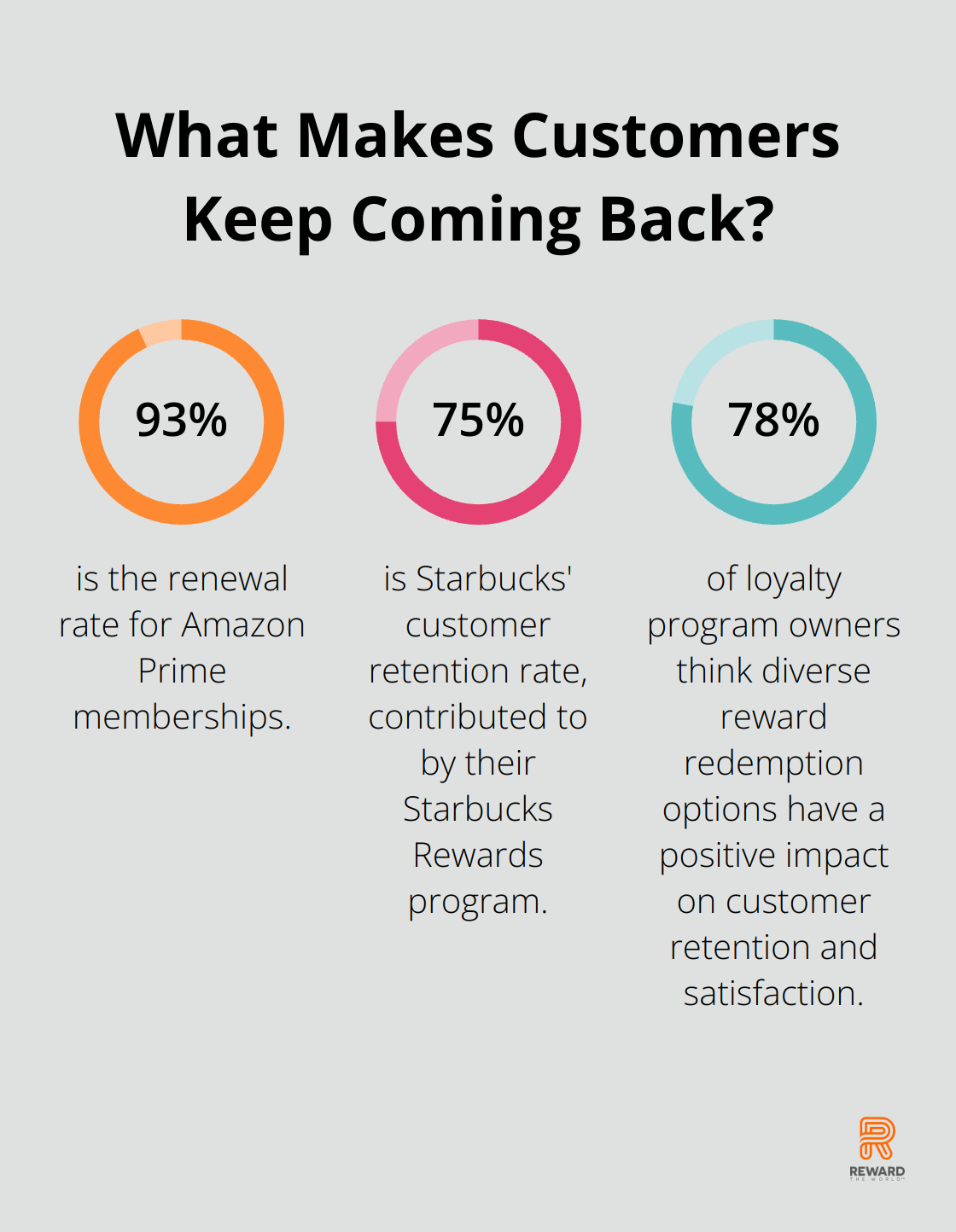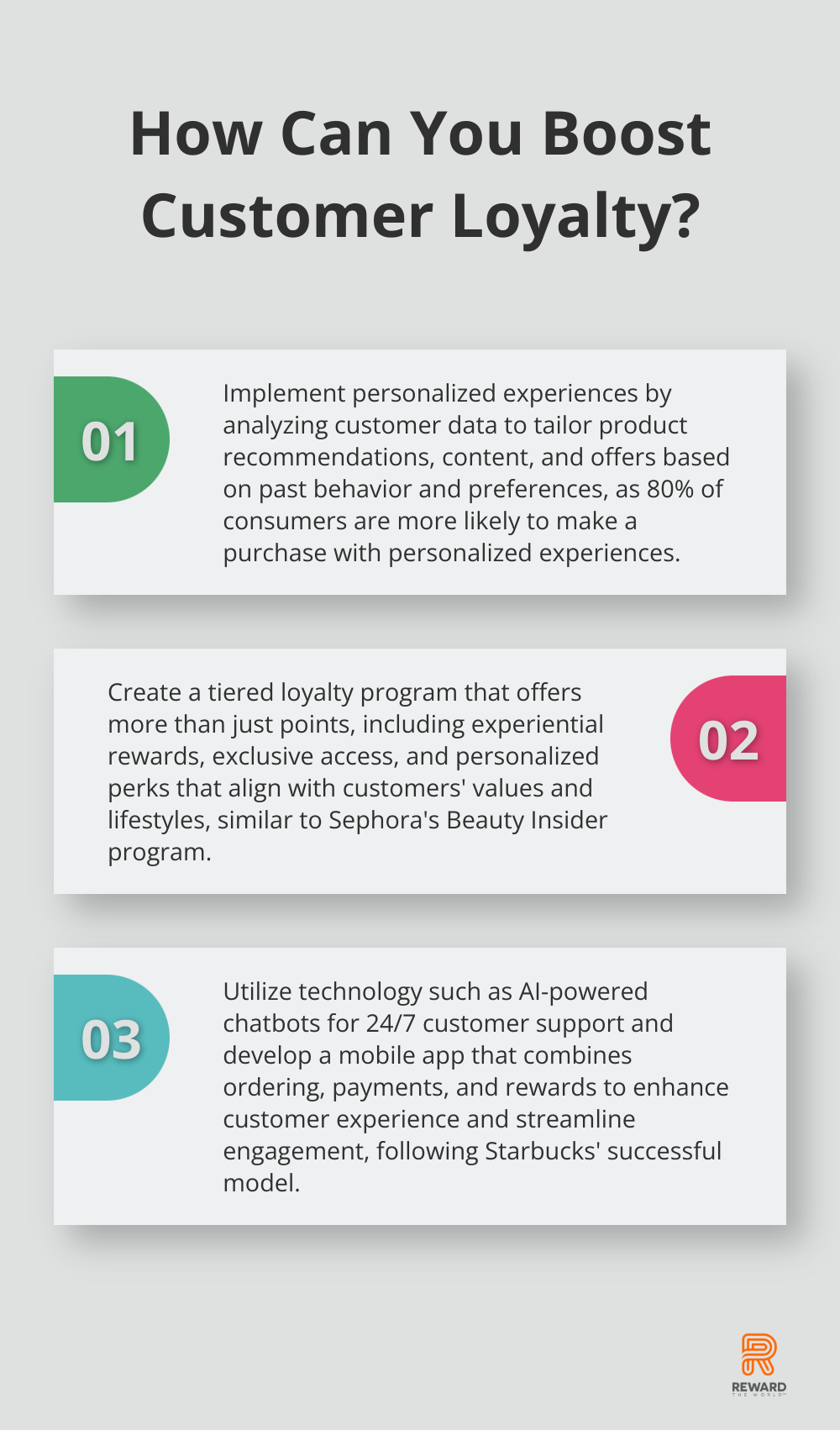
Customer loyalty is more than just a buzzword-it’s a powerful driver of business success. At Reward the World, we’ve seen firsthand how loyal customers can transform a company’s bottom line.
But what’s the real impact of customer loyalty on customer retention? This blog post: “Does Customer Loyalty Boost Retention Rates?” dives into the connection between these two crucial metrics and explores strategies to boost both.
How Loyalty Drives Customer Retention
The Loyalty-Retention Connection
Customer loyalty and retention form two essential pillars of business success. Customer loyalty represents the emotional bond and commitment a customer develops towards a brand, resulting in repeat purchases and positive recommendations. Customer retention measures a company’s ability to maintain its customer base over time.

Loyalty significantly influences customer behavior. Loyal customers don’t just make repeat purchases; they transform into brand advocates. These customers show a higher likelihood to try new products, provide valuable feedback, and recommend the brand to their social circles. This behavior directly correlates with improved retention rates.
Loyalty and Retention: The Numbers Speak
Let’s examine some compelling statistics that highlight the power of customer loyalty:
- A study by Bain & Company reveals that a mere 5% increase in customer retention rates can boost profits by 25% to 95%. This figure underscores the substantial financial impact of maintaining a loyal customer base.
- Marketing Metrics reports that the probability of selling to an existing customer stands at 60-70%, while the probability of selling to a new prospect is only 5-20%. This stark contrast demonstrates why focusing on loyalty often proves more profitable than constantly pursuing new customers.
The Impact of Loyalty Programs
Loyalty programs serve as a key tool in cultivating customer loyalty and improving retention. Studies have shown that customer loyalty programs are positively correlated with customer retention in the retail industry. This underscores how structured loyalty initiatives can directly influence retention rates.
The Cost-Effectiveness of Loyalty
One of the most persuasive arguments for prioritizing loyalty lies in its cost-effectiveness. Customer acquisition and customer retention are two metrics used mainly to determine the return on investment (ROI) for efforts to monetize consumers. This cost difference presents a strong case for prioritizing loyalty and retention strategies.
Moreover, loyal customers tend to spend more. A study by InMoment found that 61% of loyal customers will go out of their way to buy from specific brands. This increased willingness to purchase (combined with the lower cost of retention) creates a powerful economic incentive for businesses to focus on loyalty.
Loyalty in Action: Real-World Examples
To illustrate the power of loyalty in driving retention, let’s look at some real-world examples:
- Amazon Prime: This subscription-based loyalty program has significantly boosted Amazon’s customer retention. Prime members spend an average of $1,400 annually on Amazon, compared to $600 for non-members.
- Starbucks Rewards: With over 16 million active members in the U.S., this program has contributed to Starbucks’ impressive customer retention rate of 75%.
- Sephora’s Beauty Insider: This tiered loyalty program has helped Sephora achieve a retention rate of 80%, well above the retail industry average.
These examples demonstrate how effective loyalty campaigns can translate into tangible improvements in customer retention rates.
As we move forward, it’s clear that understanding and leveraging the link between loyalty and retention can lead to significant business benefits. In the next section, we’ll explore specific strategies that businesses can employ to build and strengthen customer loyalty.
How to Build Unshakeable Customer Loyalty
Personalize Every Interaction
Personalization stands as a cornerstone of customer loyalty. A study by Epsilon reveals that 80% of consumers are more likely to make a purchase when brands offer personalized experiences. This extends beyond using a customer’s name in emails; it involves tailoring product recommendations, content, and offers based on past behavior, preferences, and demographics.

Netflix’s recommendation engine exemplifies effective personalization. By analyzing viewing habits, it suggests content that each user will likely enjoy, which keeps them engaged and subscribed. Businesses can implement similar strategies by using customer data to create personalized marketing campaigns, product suggestions, and even customized loyalty program rewards.
Create a Compelling Loyalty Program
Loyalty programs remain one of the most effective tools for building customer loyalty. The most successful ones offer more than just points for purchases. They provide experiential rewards, exclusive access, and personalized perks that resonate with customers’ values and lifestyles.
Sephora’s Beauty Insider program offers tiered rewards, early access to products, and exclusive events, creating a sense of exclusivity and community among members. This approach has contributed to Sephora’s impressive retention rate (significantly higher than the retail industry average). However, Reward the World’s platform offers even more flexibility and customization options for businesses looking to create compelling loyalty programs.
Deliver Consistent Quality and Exceptional Service
Consistency in product quality and service excellence form the foundation of customer loyalty. A study by PwC found that 73% of consumers point to experience as an important factor in their purchasing decisions, behind price and product quality.
Zappos is renowned for its commitment to customer service. Their policy of free returns and exchanges, coupled with their legendary customer support (including a record 10-hour customer service call), has earned them a fiercely loyal customer base.
Leverage Technology for Enhanced Customer Experience
In today’s digital age, technology plays a vital role in enhancing customer experience and fostering loyalty. AI-powered chatbots can provide instant, 24/7 customer support, addressing queries and resolving issues promptly.
Mobile apps provide a direct channel to engage with customers, offer personalized deals, and streamline the purchasing process. Starbucks’ mobile app, which combines mobile ordering, payments, and their rewards program, has been a significant driver of their customer loyalty.
Embrace Social Responsibility
Modern consumers (especially millennials and Gen Z) increasingly prefer brands that align with their values.
TOMS Shoes exemplifies how social responsibility can drive customer loyalty. Their “One for One” model, where they donate a pair of shoes for every pair purchased, has created a strong emotional connection with customers who feel they’re making a positive impact with their purchase.
These strategies can help businesses create a loyal customer base that not only makes repeat purchases but also becomes brand advocates. The next section will explore how to measure the impact of these loyalty-building efforts on customer retention rates.
How to Measure Loyalty’s Impact on Retention
Key Metrics for Loyalty and Retention
Several metrics help gauge the relationship between loyalty and retention:
- Customer Lifetime Value (CLV): This metric calculates the total worth of a customer to a business over the entire relationship. Higher CLV often correlates with increased loyalty and retention.
- Net Promoter Score (NPS): NPS measures customer loyalty by asking how likely customers are to recommend a company. A study by Bain & Company found that companies with the highest NPS in their industry tend to outgrow their competitors by more than two times.
- Repeat Purchase Rate: This metric shows the percentage of customers who make multiple purchases. A high repeat purchase rate indicates strong loyalty and retention.
- Customer Churn Rate: The percentage of customers who stop doing business with a company over a specific period. A lower churn rate suggests better retention.
- Customer Effort Score (CES): This measures how easy it is for customers to do business with a company. Lower effort often leads to higher loyalty and retention.
Tools for Measuring Loyalty and Retention
Various tools help businesses track these metrics:
- Customer Relationship Management (CRM) Systems: Tools like Salesforce or HubSpot track customer interactions, purchases, and feedback, providing insights into loyalty and retention.
- Survey Tools: Platforms like SurveyMonkey or Qualtrics help collect customer feedback and calculate NPS.
- Analytics Platforms: Google Analytics tracks user behavior on websites and apps, helping businesses understand customer engagement and retention.
- Loyalty Program Software: Specialized software (like Reward the World’s platform) tracks reward redemptions, engagement rates, and other loyalty-specific metrics.
Success Stories in Loyalty and Retention
Let’s examine some companies that have successfully leveraged loyalty to boost retention:
- Amazon Prime: This program has transformed Amazon’s business model. Prime members spend an average of $1,400 annually on Amazon (compared to $600 for non-members). The renewal rate for Prime memberships stands at an impressive 93%, showcasing its impact on retention.
- Starbucks Rewards: With over 16 million active members in the U.S., this program has contributed to Starbucks’ customer retention rate of 75%. The program’s success lies in its simplicity and the tangible benefits it offers frequent customers.
- Nike Membership: Nike’s loyalty program has helped the company achieve a retention rate of 80%. The program offers exclusive products, early access to sales, and personalized workout recommendations, creating a comprehensive ecosystem that keeps customers engaged.

These examples demonstrate how well-executed loyalty programs can significantly impact retention rates. However, it’s important to note that while these programs have been successful, 78% of loyalty program owners think diverse reward redemption options have a positive impact on customer retention and satisfaction. Reward the World’s platform offers even more flexibility and customization options, allowing businesses to create loyalty programs tailored to their specific needs and customer base.
Businesses should consistently track these metrics and learn from successful case studies to gain valuable insights into the relationship between loyalty and retention. This data-driven approach allows for continuous improvement of loyalty strategies, ultimately leading to higher retention rates and business growth.
Final Thoughts
Customer loyalty significantly impacts customer retention rates. Loyal customers make repeat purchases, become brand advocates, and drive both retention and acquisition. The statistics we’ve examined clearly show that focusing on loyalty can lead to substantial increases in retention rates and profitability. Businesses should take actionable steps to improve loyalty and retention, such as personalizing customer interactions, implementing compelling loyalty programs, and consistently delivering high-quality products and exceptional customer service.

At Reward the World, we understand the critical role that loyalty plays in driving retention and overall business success. Our global incentives platform offers a comprehensive solution for businesses looking to boost customer loyalty and retention. With a vast array of reward options, seamless integration, and powerful analytics, we provide the tools needed to create and maintain strong customer relationships.
Building customer loyalty requires continuous effort and adaptation to create meaningful connections with customers. Businesses that focus on consistently delivering value can foster loyalty that translates into improved retention rates and long-term success (without relying on short-term tactics). The impact of customer loyalty on retention rates cannot be overstated, making it a worthwhile investment for sustainable growth.
